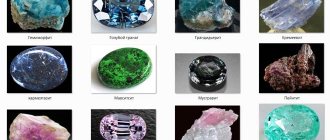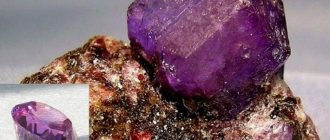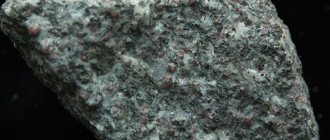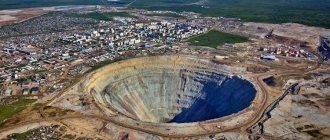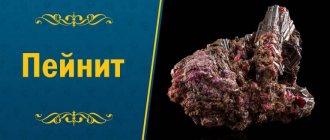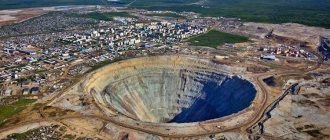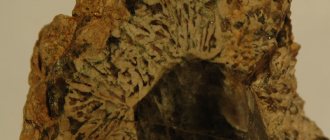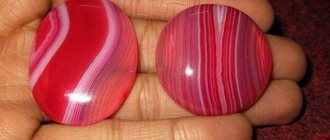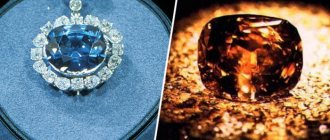A uniquely beautiful creation of nature - a durable mineral box with a surprise in the form of semi-precious crystals inside - is called by the simple Greek word “geode” (with a slight French accent).
Finding a geode is not easy, recognizing it is even more difficult, but the result will make you freeze with admiration. What is a geode?
From a geological or mineralogical point of view, any geode is a closed cavity in the rock, inside of which there are crystals of a particular mineral. The word "geode" means "spherical" and is of Greek origin. A geode consists of a hard shell-case (sometimes layered) partially filled with mineral.
The main feature of natural geodes is that the crystals that fill them will always be different from the rock in which they are found. Thus, amethyst geodes are never formed among amethysts; agate geodes cannot be found among an array of agates.
In nature, geodes form in rocks both on the surface of the earth and on the ocean floor.
In general, the geode formation scheme looks like this:
- the earth's crust cracks or cavities form in it due to volcanic activity;
- water containing minerals in the form of salts seeps into the cavity through surface cracks;
- gradually a mineral deposit forms on the walls of the cavity;
- as soon as the concentration of mineral sediment becomes sufficient, the crystallization process begins (depending on what mineral settles on the walls of the cavity, this takes tens, hundreds, and sometimes thousands of years);
- Mineral layers or crystals form inside the cavity.
Types of geodes
Classification can be based on various characteristics. In mineralogy, the main characteristics for classification are usually the mechanism of formation, composition, color, shape and size.
Education mechanism
Scientists identify two main mechanisms:
- Recrystallization
. Formed crystals are subject to destruction due to an earthquake, volcanic eruption or other natural disaster. Thermal water washes away impurities from the destroyed crystals, and the remaining minerals begin to crystallize again. This variety is highly valued by jewelers due to the purity and high quality of the crystals formed. - Metasomatism
. Occurs when one mineral is partially replaced by another inside a stone cavity.
Compound
Classification by composition will be determined by the mineral that occupies the main volume in the geode:
- simbircite (ammonite)
- are fossils (shells of ancient mollusks) with pyrite or marble simbircite inside; - ferromanganese
- most often formed at the bottom of seas or oceans; - silica
- formed in limestone and contain crystals of various types of quartz; - limonites
- found in ores with a high concentration of iron.
Color
The base mineral is responsible not only for classification by composition, but also by color. Thus, citrine geodes are predominantly yellowish-green, amethyst have a purple tint, and agate has alternating layers of different colors (such geodes are formed with layered rather than crystalline filling).
Form
In nature, geode cavities of various configurations are formed. In most cases, the geode takes the shape of an oblate spheroid. Formations of a regular spherical shape are considered the most valuable, but they are extremely rare.
Dimensions
Geodes are usually called geological formations that have a void inside, ranging in size from 1 to 100 cm. If the formation is smaller, it is an amygdala; if larger, then it is a cave. Not all scientists agree with this classification, so the largest geode on the planet is considered to be the Cave of Crystals, located in the American state of Ohio.
Mineral color
The color and color of minerals are very, very diverse. They depend on the chemical composition, inclusions of other substances, structural features of the mineral and are the most important diagnostic feature. But it happens (and quite often) that the color of the same species can vary within very wide limits. Some minerals change color when crushed or worn down. For example, pyrite in individual crystals is brass-yellow in color, but in powder it is black. By this property it is easily recognizable.
The color may be inherent to the substance of the mineral itself, that is, due to the presence in the mineral of so-called chromophores - the chemical elements chromium, manganese, iron, cobalt, nickel, copper, titanium. This coloration is called idiochromatic
. But color can also be due to some defects in crystal structures, “iridization” - inhomogeneous refraction and reflection of light due to lamellar heterogeneity of the crystal.
Many minerals get their name from their characteristic color. For example, albite is white in translation, orpiment is golden in color, hematite is bloody, celestine is sky blue, citrine is yellow, etc. From the same Persian root meaning the word “blue”, the names of the three blues came from minerals – azurite, lapis lazuli, lazulite
.
But for the most part, flower names exist in Greek and Latin
. Celestine.
Constant (not changed by different conditions) color of the mineral is of paramount importance.
Sulfur is always yellow, azurite is always blue, malachite is green, rhodochrosite is pink, etc.
And at the same time, the color of the stone can change. depending on different conditions. This can happen due to the presence of impurities.
For example, calcite can be colored by impurities in blue, lilac, yellow and other colors. Red ruby and pyrope, green emerald and uvarovite owe their color to chromium impurities. Chromium-bearing alexandrite and kemmererite are green in sunlight and violet in electric light.
The widespread occurrence of iron and chromium in the earth's crust explains the reason for the distribution of brown, red and green shades in minerals. In contrast, there are comparatively very few blue minerals.
Celestine.
The color of a mineral always refers to the primary colors; idiochromatic, heterogeneous colors can serve as additional diagnostic features.
The color of a mineral must be determined on a fresh, clean surface of a facet or fracture, when it is not masked by deposits, oxides, weathering, or films.
Tarnishing is a specific play of light or another additional effect, and sometimes an iridescent coloring of the surface, characteristic of minerals with a metallic luster. Some chalcedony has a bright blue color due to light scattering in the microporous surface layer. When moistened, the color disappears, and when it dries, it appears again.
The color of the streak is very important in identifying minerals. The mark left on the matte, unglazed surface of the porcelain consists of a fine mineral powder. The color of the streak is not as saturated, bright and rich in shades as the color of the crystals, but it is a more permanent sign that is used in identifying opaque, densely colored minerals that are difficult to identify.
Light-colored minerals usually show a uniform white streak.
By the color of the crystals and the color of the trait, it is sometimes possible to determine the presence of chemical impurities and the place of the mineral in the isomorphic series. The color and character of dark minerals must be viewed under bright light.
Where to find a geode and how to distinguish it from an ordinary stone
A geode with semi-precious crystals inside is a valuable object, sought after by collectors, jewelers, and scientists. However, there is no industrial mining of geodes; their deposits do not exist. The search for semi-precious cavities is carried out by scientists and amateurs essentially manually, by touch. Neither knowledge of geology nor preliminary exploration helps in finding geodes. Even if you manage to find a geode, there is no guarantee that what will be inside will be a valuable amethyst or citrine, and not ordinary quartz.
A closed geode is very similar to a regular stone with a bumpy surface. You can suspect a geode in a sample you come across by its shape (it is usually flattened spherical) and by its sound (when you tap, you can hear emptiness inside).
You can open a geode using a saw with a diamond blade, a pipe cutter, a chisel or a sledgehammer. When carrying out such work, it is important to follow safety precautions and act carefully so as not to damage the internal crystals.
Crystal forms
Every lover of mineral collections will try to enrich them with a certain number of crystalline forms of their own making. For this purpose, he will acquire clay, alabaster, chalk, talcum powder, soap, etc., or thick paper, on which he will first make the appropriate drawing, then tear it along the drawn contours and glue it carefully.
Cost of geodes
The price of a geode, as well as its scope of application, will depend on its main characteristics - the size and composition of the mineral filler. A limonite specimen with dimensions of 100x60x40mm can be purchased for 300-500 rubles, an agate specimen of similar sizes will cost from 3 thousand rubles, and an amethyst specimen of the same dimensions will cost 9-10 thousand rubles or more.
Diamond deposits
Let's look at which countries produce diamonds.
Russian mines
The first mineral was found in the Perm region (Krestovozdvizhensky mine) in 1829. Over the next 28 years, diamonds totaling 60 carats were mined in this region. The first Siberian diamond found (mine near Yeniseisk) dates back to 1879.
Kimberlite pipe "Mir"
And in 1949, high-quality diamonds were found in the Vilyui River basin (Yakutia). Later, in the 1950s, the Zarnitsa kimberlite pipe was discovered in Yakutia. In 2012, diamonds were found on the border of the Krasnoyarsk Territory and Yakutia (Poligai deposit). But, despite the expansion of mining boundaries, Ural diamonds remain the highest quality minerals.
According to the latest information, diamonds with a total weight of 30-40 million carats are mined in Russia per year.
Areas of application
Each geode is unique; in nature, no two are identical or even very similar. The scope of application will depend on its size and composition:
- small almonds with semi-precious crystals are used as inserts in jewelry (they are sawn in half and framed with metal);
- the largest and most beautiful specimens are transferred to museums as exhibits;
- medium and large geodes adorn private collections.
Small specimens are used as amulets for the home or office.
Amethyst Geode
8230 rub.
Amethyst Geode
10240 rub.
Amethyst Geode
8720 rub.
See all
Beauty life hack
In recent years, a fashion trend – gouache – has become increasingly popular. This is an ancient Chinese technique of facial and body massage, for which a special scraper is used in the form of a plate that is pleasant and smooth to the touch. Most often, such scrapers look like two- or three-fingered legs, less often they are found in the shape of a fish or square. They are made from jade, opal and quartz. It is believed that when used regularly in combination with essential oils, such a beauty gadget can rid the face of swelling, improve lymph flow, smooth out fine wrinkles and make the oval of the face more defined and toned.
How to grow a geode at home
It is quite possible to grow a geode at home.
Most crystals, of course, grow very slowly and are extremely demanding in terms of formation conditions, but there are also those whose cultivation does not require any special skills or long years of waiting. You can purchase a crystal growing kit or use the following recipe. The following components will be required:
- potassium alum;
- dye (it must be water soluble);
- water;
- chicken egg shell;
- glue (insoluble in water).
The eggshells must be carefully divided in half, washed and dried thoroughly.
Spread a thin layer of glue on the inner surface of the shell with a brush, and then sprinkle it with two pinches of potassium alum. Allow the egg mixture to dry thoroughly. Boil 0.5 liters of water, add ¾ cup of alum into it, stir until the alum dissolves. Then add dye until the desired shade is obtained. The resulting solution must be cooled and poured into two glasses. The next step is to lower the egg mixture into the solution so that its outer side is at the bottom of the glass.
To form a geode from potassium alum, 15 hours is enough. The more time passes, the larger the crystals will become.
Magical properties of geodes
It is believed that the magical properties of a geode are much more powerful than the magic of a similar single crystal. Any such education will be an ideal means for harmonizing the energy microclimate - both at home and at work. The magical specialization of a geode will depend on its mineral composition, for example:
- agate
protects against negative influences (physical, mental, magical), protects against the attacks of energy vampires, and is suitable for the role of a magical protector for a child or a person who has to work in interaction with a large number of people. - Chalcedony
cleanses the living space and organizes thoughts, relieving the owner of any negativity. - Amethyst geodes
stabilize the psycho-emotional state, help cope with stress, maintain energy balance and prevent loss of strength.
The larger the geode, the more magical power it has. There is also an opinion that you can voice your cherished desires into the geode cavity, and they will come true.
